Problem: The fleet of aircraft trainers in the USA is getting old. The familiar, reliable standard is the Cessna 172. While these are being made brand new, their base cost has risen to half a million dollars. Meanwhile, much more affordable vintage 172s normally have dated instrument panels and the airframe often looks well-worn. Built in the last decade or so, nearly all LSA have fully digital cockpits among other modern features. [Update 9/15/22 — see new info regarding trim. —DJ]
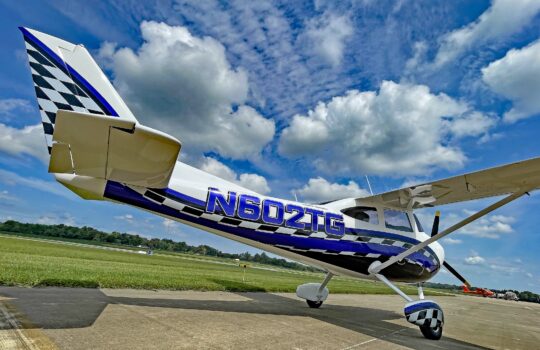

In recent years, Chip reported that he examined and flew many LSA and finally found exactly what he was looking for when he came across Orlican’s M-8 Eagle. I went aloft with this talented pilot to see how the new model compares.
Describing M-8 Eagle
Orlican’s M-8 Eagle seems made for pilots seeking a general aviation-like familiarity. With that goal, this is one of the best executions I’ve seen. Such a statement is tough because quite a few other LSA are close on Eagle’s tail. Indeed, many other airplanes have a much longer history to go along with their desirable features.
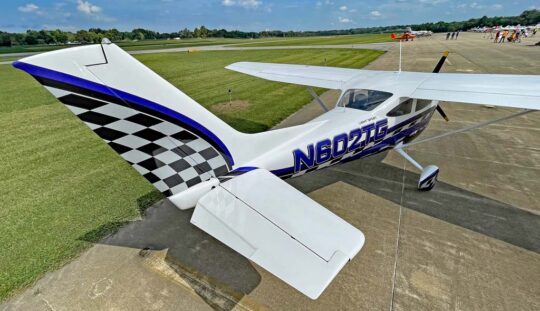
Although new to the market, one cannot deny that engineers at Orlican have created, developed, and begun to produce an airplane that may prove very competitive in the like-a-GA-airplane space.
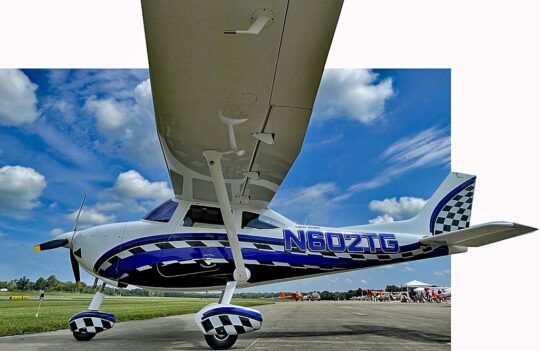
A giant difference between the two: price. Orlican’s M-8 Eagle is around $150,000 where a new Cessna 182 is $600,000 base price. Four times as much is a big difference but, to be fair, this is somewhat apples and oranges. A 182 carries more, flies 145 knots on 230 horsepower, and seats four. M-8 Eagle does not. Both feature fully-digital cockpits — used 182s rarely do.
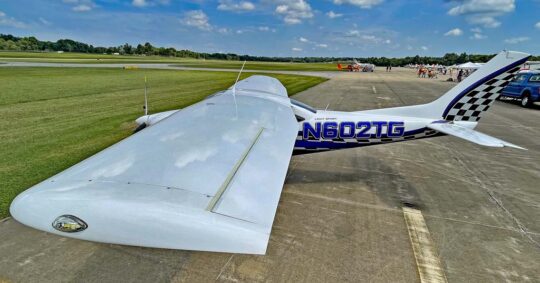
Construction — Further unlike the 182, M-8 Eagle uses a carbon fiber airframe. This permits smooth curves and no rivets to disturb airflow over the surfaces. Of course, carbon fiber is valued for its great combination of strength and light weight. A three-blade, ground-adjustable Woodcomp Propulse propeller features carbon fiber blades.
Our test M-8 Eagle had a Dynon HDX installed with autopilot and central panel controls duplicating those available via software buttons. Two small analog instrument back up the electronics. An analog inclinometer may help students more easily see how their control coordination is developing.
A four-position fuel selector has a smart design that will not let you push the start button until the fuel selector is moved from the off position. You can select left or right, which may be useful, because fully-loaded with fuel M-8 Eagle can carry 34 gallons.
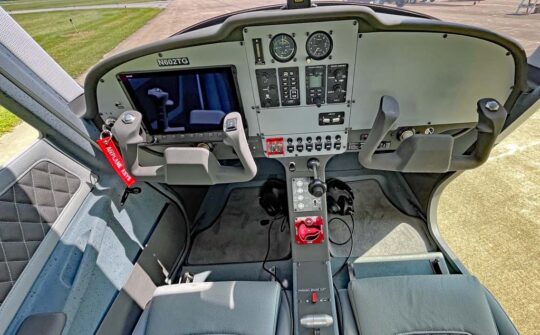
In this Eagle, a central control console houses the brake lever with a parking feature relying on a hydraulic valve lock. At the center base of the main panel, you find a vernier throttle plus choke. Below the throttle are the flap buttons and switches for fuel pump and landing light. Flap buttons and the switches are all colorfully lit to easily see their state of function.
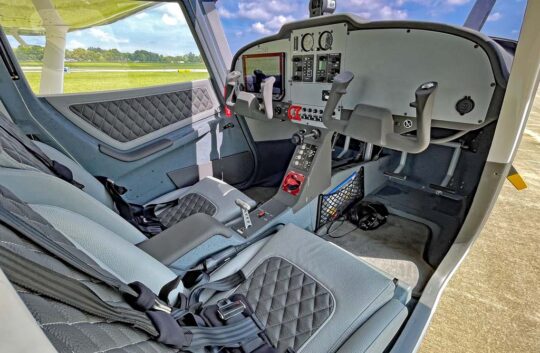
Update… Since the Midwest LSA Expo, Chip employed capabilities of the Dynon HDX to route the trim control through the instrument so that its sensitivity could be adjusted in a dynamic way. Now, as Eagle flies faster, trim sensitivity has been reduced. This is a savvy way to use digital instrumentation to solve a problem.
Flaps – Contrasted with the trim, flaps could not be easier. Hit a button, check its glowing light and return to flight controls. It is beautifully executed and works well. The preset positions result in extension to 15, 30, and 40 degrees. They can be moved to any other position after assuring you are within flap extension speed.
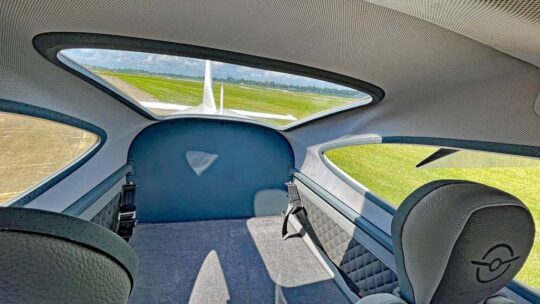
Eagle had sewn leather seats and the interior is completely finished to a high quality. No wires or cables are visible. Seat are length and height adjustable and you can move the seats fore and aft while sitting in them. Seats also have a head rest. Four-point seat belts were provided.
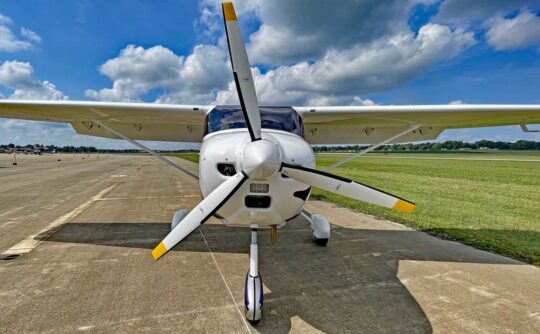
The nose wheel its fully steerable and response to pedal movement is crisp and effective.
M-8 Eagle has aerodynamic carbon fiber wheelpants and wingstrut covers. Tie down rings are provided on both wings and at the rear of the fuselage. A towbar is provided for maneuvering on the ground.
Flying M-8 Eagle
Handling — Pilots familiar with yokes (most of you) should feel instantly comfortable. A center mounter vernier throttle allows pilots like Chip and others to accelerate smoothly by twisting the throttle steadily. By the time it was fully open, M-8 Eagle was ready to fly and off we went, climbing out beyond 1,000 feet per minute. En route climb was better than 700 feet per minute.
Eagle was extraordinarily well behaved in turns. It took almost no stick or rudder movement to go around in circles even at a 45-degree bank angle.
I almost never used the trim, for two reasons. Most importantly, Eagle coordinates well and has light enough controls that it simply doesn’t require much trim. However, as mentioned above, trim as presently implemented is too quick to be useful without practice. The left-yoke-mounted switch took the a merest poke of the button to move and that was often more than I sought. It was tricky to use. This was one of the few complaints I could muster for this new model.
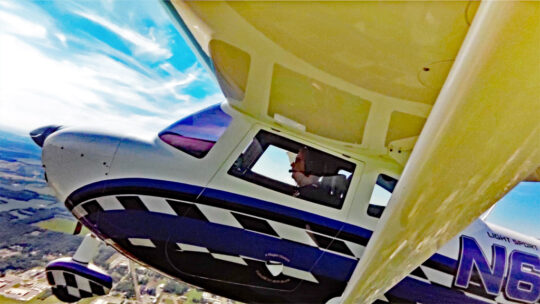
As we performed slow flight and checked cruise speed, the flaps were easily operated. Four buttons located on the center console permit one-touch flap extension or retraction. M-8 flew slowly at 45 knots — not even close to stall — with lateral control slowed but effective. At near full throttle, M-8 Eagle averaged 105-110 knots at a low altitude (2-3,000 feet AGL on a warm day).
Eagle will burn 3-5 gallons per hour, where a 182 will burn more than 10 gallons an hour. At today’s prices, that is a substantial difference, one that is very important to an active flight school.
M-8 Eagle with the carbureted 100 horsepower Rotax 912 ULS will roll about 490 feet, about half what it takes a Skylane to break away from terra firma.
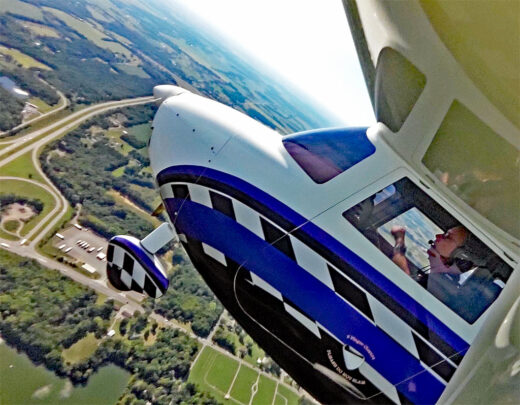
Every stall we tried, including mine where I went more suddenly into a low power approach-type stall, resulted in the most gentle of nose drops and a quick return to non-stalled flight.
Only one stall, an accelerated stall to the right, broke somewhat more abruptly but in every other trial it was impossible to make Eagle behave badly.
In every case, stall brought the airspeed indicator down into the 30s. I witnessed stall breaks — if you can call them such; stalls break very gently — at 33-37 knots. Students and experienced pilots will enjoy Eagle’s slow-speed capability.
Although Chip did not select it for his flight school M-8 Eagle, a whole-airframe ballistic recovery system is available; such “rescue systems” are required in Germany so most European brands have worked out installation.
When I went aloft with Chip, I quick realized I was on board with a thoroughly professional instructor. Since he investigated many LSA quite carefully and chose M-8 Eagle for his flight school, it shows this second-generation entry is ready to fly! I can practically guarantee a smile will follow.
ARTICLE LINKS:
- Orlican company website
- Aeropilot USA, American representative for Orlican
- Article introducing M8 Eagle, on this website
TECHNICAL SPECIFICATIONS
Orlican M8 Eagle
all figures supplied by the manufacturer
- Wing Span — 29.8 feet (9 meters)
- Wing Area — 116 square feet (10.7 square meters)
- Length — 23 feet (7 meters)
- Height — 8.7 feet (2.65 meters)
- Horizontal Tail Width — 9 feet (2.8 meters)
- Empty Weight, base — 728 pounds (330 kilograms)
- Maximum Take-off Weight — 1,320 pounds (600 kilograms)
- Useful Load — 592 pounds (269 kilograms)
- Fuel capacity — 34 gallons / 204 pounds (93 kilograms)
- Payload with Full Fuel — 388 pounds (176 kilograms)
- Payload at 17 gallons of fuel* — 490 pounds (222 kilograms)
- Endurance with Full Fuel — 8.5 hours
- Takeoff Roll — 490 feet (150 meters)
- Range with Full Fuel — 900 nautical miles (1450 kilometers)
- Climb Rate — 1,200 feet per minute (6 meters per second)
- Stall Speed with Flaps — 29 knots (53 kilometers per hour)
- Max Cruise Speed — 120 knots (222 kilometers per hour)
- Common Cruise Speed — 110 knots (204 kilometers per hour)
- Landing Roll — 490 feet (150 meters)
- Luggage Capacity — 66 pounds (30 kilograms)
- Cabin Width — 45.8 inches (1.16 meters)
* Enough for at least two one-hour flight lessons with generous reserve


Any updates on the particular M-8 in the photo – I read it flipped over following a engine/prop issue that forced a hard landing in December 2022. Curious how repairable the airframes are on these composite aircraft. I still want one.
NTSB Prelim: Orlican S R O M-8 Eagle
The Engine Or Propeller Began To Vibrate, And The Pilot Elected To Return
Location: St. Louis, MO Accident Number: CEN23LA061
Date & Time: December 5, 2022, 17:26 Local Registration: N602TG
Aircraft: Orlican S R O M-8 Eagle Injuries: 2 Minor
Flight Conducted Under: Part 91: General aviation – Personal
I recommend you contact the representative in the USA: Aeropilot USA
We investigated the accident and it was reported as dirty fuel causing an engine out; no fault of the factory. This aircraft flew often and had over 100 hours logged. The next demo model will be at Sun ‘n Fun 2023.
I flew 602TG and 6 other planes at Mt Vernon and hands down this was the nicest flying planes of the bunch ( and the others weren’t bad). I was close to partnering with my son on one but a local owner had a problem with something composite related on his plane and could not find anyone to repair it. Too bad because I really was interested in buying one. Now I’m looking for the second best option.
For those unable to get $150,000 together, there’s a low cost bare bones starter package with European glass panel or steam gauges starting at $135,000.
Was Aeroprakt represented at the Midwest LSA Expo? I’ve heard Dennis Long is retiring. I’m thinking about an A32 Vixxen but wondering what’s going on with U.S. representation, importation, etc….
Dennis and Aeroprakt were at Midwest. They flew actively every day. Dennis is still associated with it but has engaged Andy Humphrey of Heavenbound Aviation. This article has further information.
I backed out of a deal for one, because best insurance rate I could get was over $5,000 per annum. Too bad I did love flying it.
Will there be a video of your flight in the M-8 Eagle?
At this time, I cannot determine that. The article will have to suffice for the time being.
I was very fortunate to get a test flight with Chip. This is his personal airplane of choice, and it was easy to fly. I was able to use the trim without an issue as it took very little for level flight. Of all the LSA that I flew in Mt Vernon this was the smoothest and landed very easy.
$150,000 base price maybe affordable to you but certainly not to me.
I’m a Sport Pilot who rents, but lately I’ve had to drive over two hours to the nearest SLSA in Jacksonville. Since I live only 20 miles from Savannah, I have visited Fly Corps Aviation just before their new Eagle flew to the Midwest Expo. I can attest to its C182 resemblance and the relatively luxurious interior with the big Dynon. Can’t wait for my checkout flights!